(source: Williams: Finite Mathematics).
(source: Williams: Finite Mathematics).
In the period of British history from William the Conqueror (about 1066)
to 1399, the pattern of hereditary succession to the British throne was
clear. In 1399, the Wars of the Roses, involving issues between the
House of York and the House of Lancaster, concerning succession to the
British throne, were the result. In 1485, when Henry VII of the House
of Lancaster married Elizabeth of the House of York, the pattern of succession
once again became clear, in their son, Henry VIII. An historical
transition was achieved, but in the period from 1399 to 1485, what was
the pattern of the dispute?
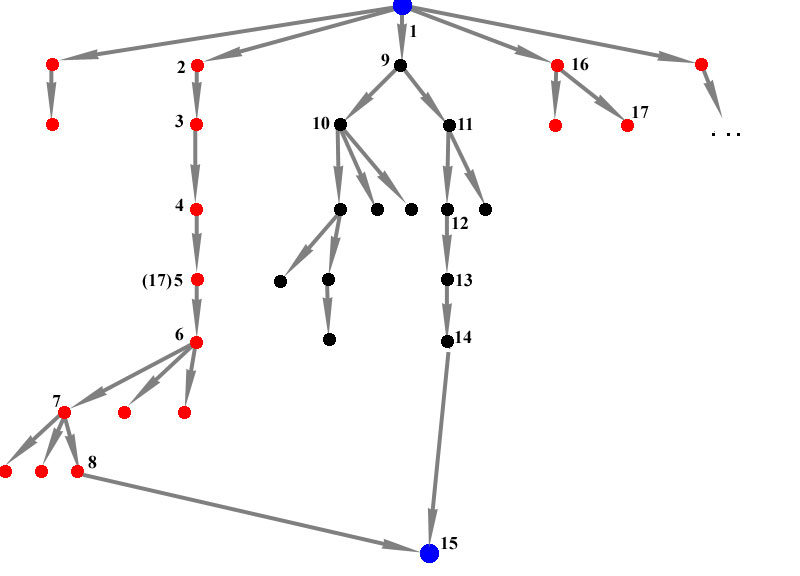 |
Adjacency matrix of the directed graph (note that it is not symmetric,
as one would expect). Adjacency is based on the one-way relationship
"is the father/mother of".
| 1 | 2 | 3 | 4 | 5 | 6 | 7 | 8 | 9 | 10 | 11 | 12 | 13 | 14 | 15 | 16 | 17 | ||
| 1 | Edward III | 0 | 1 | 0 | 0 | 0 | 0 | 0 | 0 | 1 | 0 | 0 | 0 | 0 | 0 | 0 | 1 | 0 |
| 2 | Lionel, Duke of Clarence | 0 | 0 | 1 | 0 | 0 | 0 | 0 | 0 | 0 | 0 | 0 | 0 | 0 | 0 | 0 | 0 | 0 |
| 3 | Philippa | 0 | 0 | 0 | 1 | 0 | 0 | 0 | 0 | 0 | 0 | 0 | 0 | 0 | 0 | 0 | 0 | 0 |
| 4 | Roger Mortimer | 0 | 0 | 0 | 0 | 1 | 0 | 0 | 0 | 0 | 0 | 0 | 0 | 0 | 0 | 0 | 0 | 0 |
| 5 | Anne | 0 | 0 | 0 | 0 | 0 | 1 | 0 | 0 | 0 | 0 | 0 | 0 | 0 | 0 | 0 | 0 | 0 |
| 6 | Richard, Duke of York | 0 | 0 | 0 | 0 | 0 | 0 | 1 | 0 | 0 | 0 | 0 | 0 | 0 | 0 | 0 | 0 | 0 |
| 7 | Edward IV | 0 | 0 | 0 | 0 | 0 | 0 | 0 | 1 | 0 | 0 | 0 | 0 | 0 | 0 | 0 | 0 | 0 |
| 8 | Elizabeth | 0 | 0 | 0 | 0 | 0 | 0 | 0 | 0 | 0 | 0 | 0 | 0 | 0 | 1 | 0 | 0 | 0 |
| 9 | John of Gaunt, Duke of Lancaster | 0 | 0 | 0 | 0 | 0 | 0 | 0 | 0 | 0 | 1 | 1 | 0 | 0 | 0 | 0 | 0 | 0 |
| 10 | Henry IV | 0 | 0 | 0 | 0 | 0 | 0 | 0 | 0 | 0 | 0 | 0 | 0 | 0 | 0 | 0 | 0 | 0 |
| 11 | John Beaufort, Earl of Somerset | 0 | 0 | 0 | 0 | 0 | 0 | 0 | 0 | 0 | 0 | 0 | 1 | 0 | 0 | 0 | 0 | 0 |
| 12 | John, Duke of Somerset | 0 | 0 | 0 | 0 | 0 | 0 | 0 | 0 | 0 | 0 | 0 | 0 | 1 | 0 | 0 | 0 | 0 |
| 13 | Margaret Beaufort | 0 | 0 | 0 | 0 | 0 | 0 | 0 | 0 | 0 | 0 | 0 | 0 | 0 | 1 | 0 | 0 | 0 |
| 14 | Henry VII | 0 | 0 | 0 | 0 | 0 | 0 | 0 | 0 | 0 | 0 | 0 | 0 | 0 | 0 | 1 | 0 | 0 |
| 15 | Henry VIII | 0 | 0 | 0 | 0 | 0 | 0 | 0 | 0 | 0 | 0 | 0 | 0 | 0 | 0 | 0 | 0 | 0 |
| 16 | Edmund, Duke of York | 0 | 0 | 0 | 0 | 0 | 0 | 0 | 0 | 0 | 0 | 0 | 0 | 0 | 0 | 0 | 0 | 1 |
| 17 | Richard, Earl of Cambridge | 0 | 0 | 0 | 0 | 0 | 1 | 0 | 0 | 0 | 0 | 0 | 0 | 0 | 0 | 0 | 0 | 0 |
Taking powers of the adjacency matrix counts the number of paths through
the genealogical hierarchy. There are three 1s in the first row of
the matrix A reflecting that Edward III was the father of Lionel, John
of Gaunt, and Edmund. The power A squared counts the number of paths
of length two--grandparents/grandchildren relationships. In A squared
there are 1s in the third, tenth, eleventh and seventeenth columns, indicating
that Edward III was the grandfather of Philippa, Henry IV, John Beaufort
and Richard. The columns show the previous generation related to
a given individual. For example, Richard Duke of York's ancestors
can be read by looking at the sixth column. From the sixth column
of A, Richard Duke of York is the son of Anne and Richard of Cambridge;
the the sixth column of A squared, he is the grandson of Roger Mortimer
and Edmund Duke of York. These observations tally with the family
tree.
Matrix A
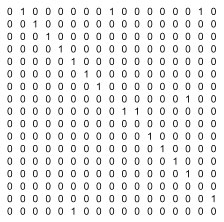 |
Matrix A squared
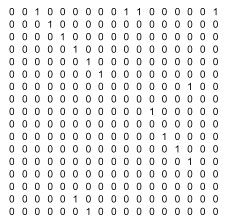 |
Matrix A cubed
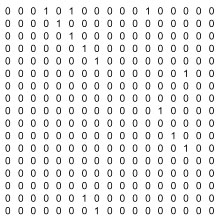 |
....... | Matrix A to the fifth
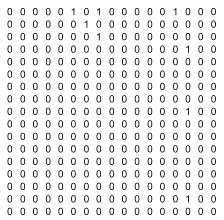 |
Matrix A to the sixth
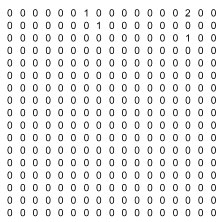 |
The fifth power of the adjacency matrix has a value of 1 in the (1,14) position of the matrix showing that there is one path of length five between Edward III and Henry VII; that Henry VII was descended directly from Edward III through five Lancaster generations. Because a value of 1 is recorded in this position for the first time in the fifth power matrix, we know that it is exactly five, and not fewer, generations for the descent.
The fifth power of the adjacency matrix also shows an entry of 1 in the (1,8) position showing that Elizabeth is descended over five York generations (1 | 16 | 17 | 6 | 7 | 8 ).
In the matrix A to the sixth, there is an entry of 2 in the position (1,15) indicating that Henry VIII, the son of Henry VII of Lancaster and Elizabeth of York, is descended over six generations and that in the sixth generation he combines the claim of both the Houses of York and Lancaster to the British throne. Both Elizabeth and Henry are descended from Richard III over the same number of generations: a 1 from each line of descent. Spatial and temporal analysis, using adjacency matrices, can resolve complexity easily, especially with software programs that quickly calculate powers of large matrices.
What if Elizabeth of York and Henry VII had not both been descended
over the same number of generations through their respective Houses?